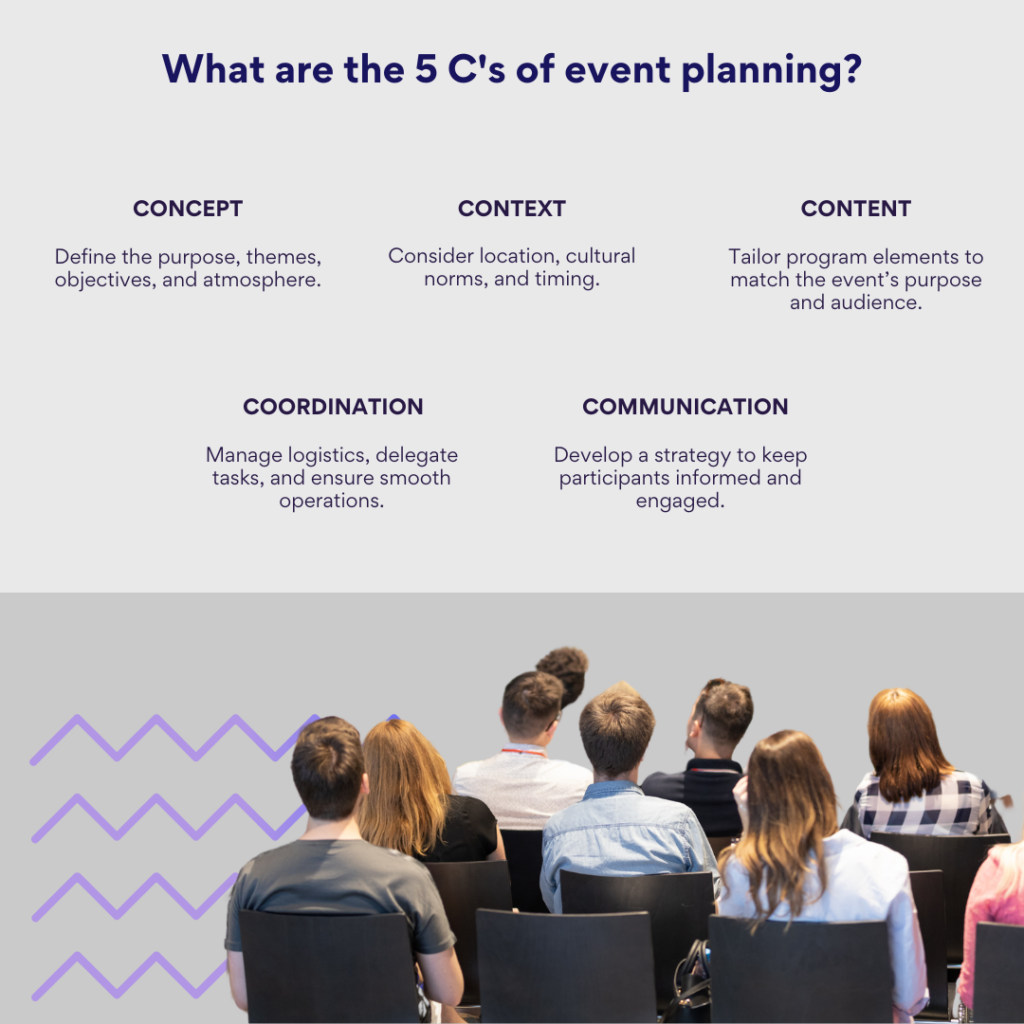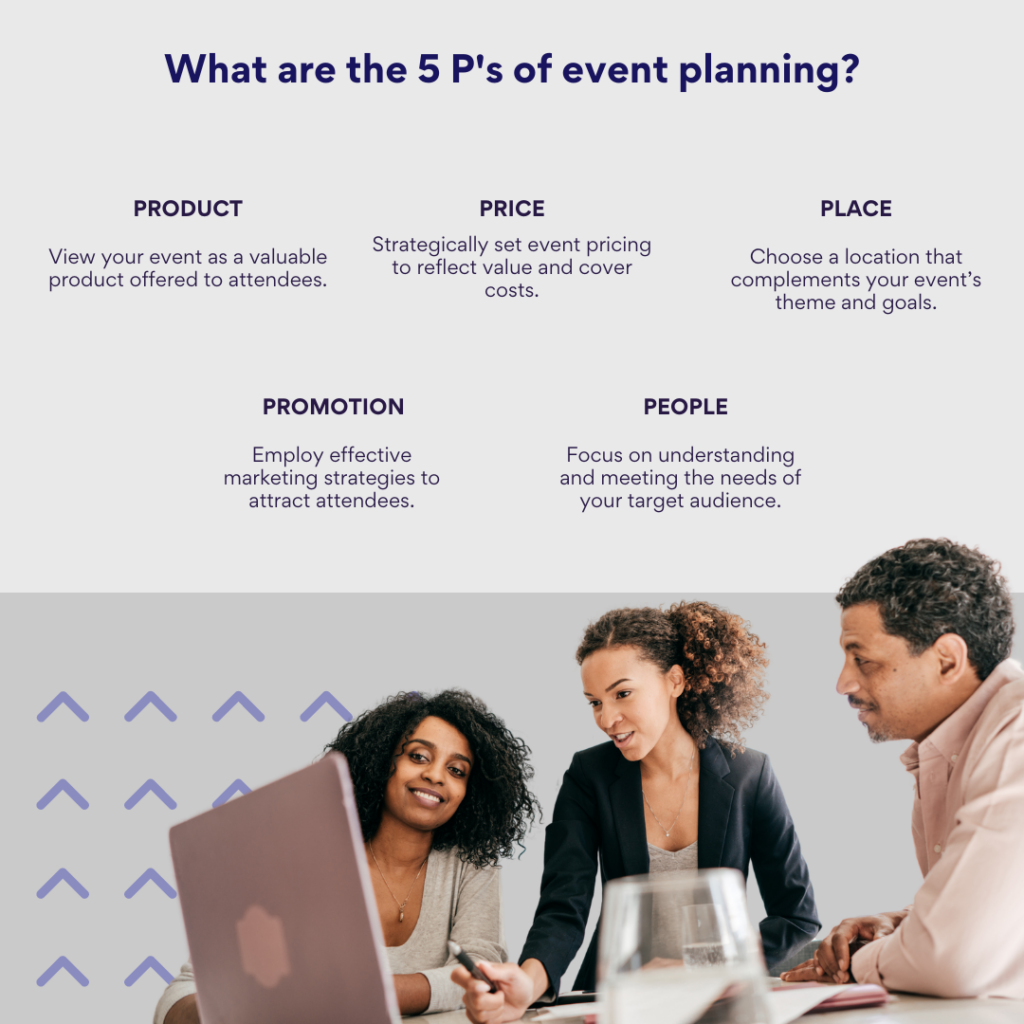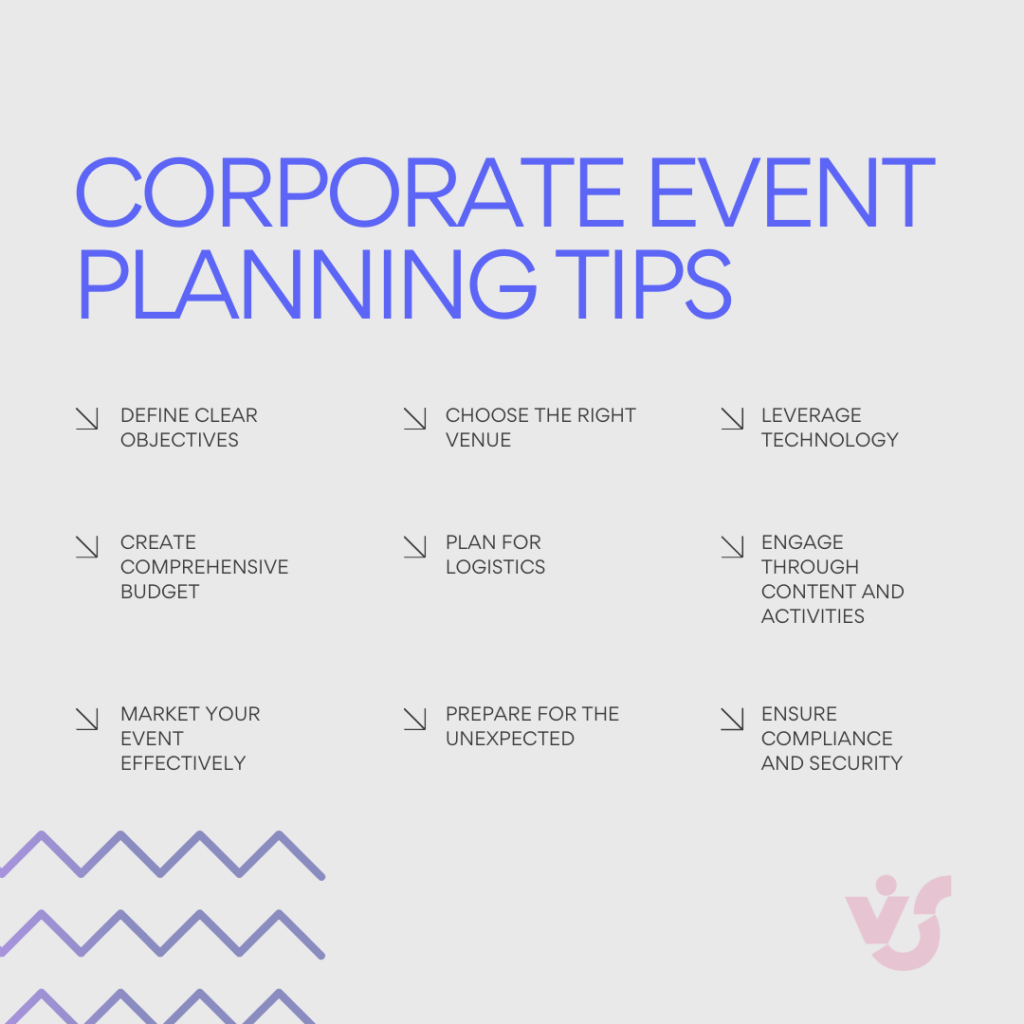Corporate Event Planning Made Easy: Guide, Ideas & Software
Creating impactful corporate events that align with broader organizational goals requires thoughtful orchestration of myriad details behind the scenes. In this article, we'll explain how best to do it.
Corporate event planning is a multifaceted discipline that involves creating, managing, and executing events for businesses. These events range from small team meetings to large international conferences, all aimed at achieving specific business objectives. Whether it’s fostering team cohesion, enhancing marketing efforts, bolstering sales, or engaging stakeholders, each event is meticulously planned to ensure maximum impact. But what is corporate event planning truly about?
At its core, corporate event planning is about organizing experiences that align with a company’s internal and external communication goals. This could involve anything from product launches, corporate anniversaries, and networking events to large-scale conventions and international summits. All of those serve as crucial platforms for team building, client engagement, and strategic marketing.
Statistics underline the significance of this industry and its growth potential. For instance, Allied Market Research forecasts industry expansion to $1.17 trillion by 2032 (1), suggesting how integral these events are to business strategies across various sectors. Upmetrics, on the other hand, reveals that 86.4% of B2B event organizers anticipate sustaining or growing in-person forums (2) despite digital proliferation—validating the irreplaceable impact of experiential engagement.
Whatever the medium—online or offline—modern technology plays a crucial role in event planning. Streamlined tools not only simplify logistics, but provide real-time visibility enabling swift optimization when required. When it comes to technology, ViroSoftware leads the pack, delivering an integrated strategic calendar application designed for enterprise-grade needs. Far beyond a basic calendar, ViroSoftware’s solutions centralize venue sourcing, booking premises globally, cross-departmental collaboration, and real-time progress tracking.
Building on this expertise, we’ll explore the nuts and bolts of corporate event planning in this article, providing you with innovative ideas and introducing you to cutting-edge software that can transform the way your business approaches events. Whether planning an inaugural local meetup or an established global summit series, multiply your influence by integrating the strategies and solutions ahead.
But before you jumpstart reading this valuable piece, why not browse related articles on our blog and deepen your time and calendar management expertise:
- Calendar Management
- Master Calendar
- Group Calendars
- Business Calendars
- Vacation Calendars
- Corporate Event Calendar
When ready, read on to start building distinctive engagement experiences that make truly lasting impressions across the board.
What Are the 5 C’s & 5 P’s of Event Planning?
Organizing a successful event, whether it’s a corporate gathering, a conference, or a social affair, requires meticulous planning and strategic execution. Among the various methodologies developed to streamline this process, two particularly effective frameworks stand out: the 5 C’s and 5 P’s of event planning. These models provide a structured approach to event management, ensuring that every critical aspect is thoughtfully addressed.
By examining the key pillars of influential event planning frameworks, you gain tools to:
- Articulate specific visions outlining attendee experiences and strategic goals fueled by the event.
- Coordinate all logistical and operational aspects to ensure the event runs smoothly and efficiently.
- Craft tailored messaging and channels nurturing consistent stakeholder communications.
5 C’s of event planning
As mentioned, the 5 C’s of event planning is a popular framework used by event planners to ensure the success of corporate and other types of events. This model helps systematically approach the complex process of event planning by breaking it down into five key components: Concept, Context, Content, Coordination, and Communication. Each component is crucial and, when executed properly, contributes to a well-rounded and effective event.
Concept
At the foundation of every event is its Concept. This encompasses the purpose, objectives, theme, format, and desired atmosphere of the event. Defining these elements early is critical as they guide all subsequent planning decisions, from venue selection to guest list.
For example, a tech conference might have a concept centered around innovation and future technologies, which could be expressed through futuristic décor, cutting-edge technology demonstrations, and keynote speeches from industry leaders. Conversely, a company retreat might aim to boost morale and team cohesion, featuring team-building exercises and a relaxed, informal atmosphere.
Context
Context involves considering the location, time of year, cultural background, and other external factors that may affect the event. Understanding the context is vital to align the event with the expectations of the attendees and to avoid any cultural or logistical missteps.
For instance, choosing a venue in a city known for its culinary delights can enhance a food marketing event, or planning an outdoor event in a season known for pleasant weather. Cultural considerations can influence everything from the event schedule to the menu—such as avoiding pork on menus in predominantly Muslim countries or scheduling events around major local or religious holidays.
Content
Content refers to the actual programming and activities planned for the event. It should align with the event’s purpose and resonate with the target audience’s interests while also fitting the overall context. Effective content creation is key to keeping guests engaged and delivering on the event’s objectives.
For a professional development seminar, content might include workshops, keynote addresses by thought leaders, and panel discussions. For a more informal event, such as a company anniversary party, content could include live music, dance performances, and interactive games.
Coordination
Coordination is the process of ensuring that all aspects of the event are managed and executed smoothly. This includes logistics, staff management, and the seamless flow of the event’s agenda. Effective coordination requires strong leadership, clear communication, and meticulous attention to detail.
Building a reliable team and delegating tasks efficiently are essential. Using tools like detailed checklists and schedules helps keep track of various elements like vendor deliveries, speaker slots, and entertainment arrangements.
Communication
Finally, Communication involves developing and implementing a plan to inform guests, participants, and other stakeholders about the event. Effective communication ensures that everyone is aware of the event details and any updates.
Various channels can be used for this purpose, including emails, social media updates, dedicated event websites, and apps. For instance, an event-specific hashtag on Twitter can help aggregate discussions and updates related to the event, while a well-maintained event calendar can keep all participants aligned on the schedule and any changes.

5 P’s of event planning
The 5 P’s of event planning is another strategic framework that helps to ensure events are engaging, memorable, and successful. Similar to the mix of 4 P’s (Product, Price, Place, and Promotion), this model adds a fifth P—People—to tailor event planning specifically to the needs of the audience. This framework is popular and handy because it covers all critical aspects of event planning, ensuring a holistic approach and maximizing the event’s overall effectiveness.
Product
In event planning, the “Product” is the event itself, viewed as a valuable offering to the target audience. Organizers must determine what benefits or experiences participants will gain, whether it’s networking opportunities, entertainment, educational content, or something else.
All elements of the event, including the concept, content, speakers, and entertainment, must synergize to deliver this value. For example, a business conference might combine high-profile speakers, practical workshops, and innovative product demonstrations to provide value through learning and networking opportunities.
Price
Setting the right Price for participating in the event involves balancing costs, desired profit margins, and the perceived value of the event. It’s crucial to offer different pricing options to accommodate various budgets and preferences, such as early bird rates, VIP packages, and group discounts.
Competitive pricing that reflects the event’s value can be achieved by thoroughly understanding market rates and participant expectations. For instance, including exclusive sessions or perks can justify higher registration fees.
Place
The Place—or venue—of the event plays a crucial role in its success. It should align with the event’s concept, accommodate the expected number of guests, and fit within the budget. Factors like the venue’s size, location, accessibility, and available amenities must be considered.
When booking venues, tools like the Virto Calendar App can be invaluable. This app facilitates the booking process, especially if the company has limited options like a single conference room or a few select venues. It ensures optimal space utilization and avoids scheduling conflicts.
Promotion
Effective Promotion is essential to attract participants and ensure the event’s visibility. This involves using a mix of marketing channels such as social media, email marketing, event websites, and possibly traditional media like radio or print ads.
Creating compelling and clear promotional materials that highlight the unique benefits of the event can significantly boost interest and attendance. Strategies might include early teaser campaigns, influencer partnerships, and targeted ads.
People
Understanding the People—the target audience—is fundamental to tailoring the event to their preferences and needs. This means considering their demographics, interests, and what they seek to gain from attending the event.
Creating an inclusive and appealing event involves meticulous guest list management and proactive engagement strategies. Maintaining a unified calendar of corporate events, like those managed through tools such as the Virto Calendar App, helps in keeping potential attendees informed and engaged, ensuring they remember and prioritize your event. Additionally, equipping your team with tools that enhance professional interactions on the ground—like digital business cards—can streamline networking and improve first impressions. Whether it’s a dynamic QR-based card, a contactless NFC format, or something sleek like Uniqode’s business card, these solutions let you share contact info instantly, update credentials in real-time, and eliminate the need to reprint physical cards.

A Guide to Corporate Event Planning: Preparing to Plan an Event & Choosing Its Format
Even before the detailed planning begins, there is a crucial stage often overlooked: preparing to plan an event. This preparatory phase is essential as it sets the foundation for the entire event planning process. Pre-planning essentials often encompass defining strategic objectives, selecting an event format, aligning stakeholders, and vetting venues. In this section, we’ll take a look at some of those components to give your event a sense of deeper purpose early on and prepare it for the myriad logistics ahead.
Determining the goals and objectives of the event
Before you start selecting venues or crafting guest lists, it’s vital to clearly define what you hope to achieve with your event. This step is not just about having a general idea but setting specific, measurable, achievable, relevant, and time-bound (SMART) objectives.
- What do you want to achieve with your event?
Events can serve a myriad of purposes: raising brand awareness, employee training, lead generation, celebrating milestones, or fostering team cohesion, among others. Identifying the primary purpose will guide every decision you make thereafter.
- How will success be measured?
Depending on your objectives, success could be measured in various ways: the number of participants, the quality of reviews received, the volume of deals concluded, or even the level of media coverage attained. Setting these metrics upfront is crucial for later evaluation of the event’s success.
Types of corporate events: Selecting the right type for your needs
Choosing the right format for your event is pivotal in meeting your previously defined objectives. Events can vary widely in their structure and intent:
- Conferences and seminars: These are typically informational and are aimed at larger groups, focusing on particular topics or industries. They are great for thought leadership and professional development.
- Team building events: These events are designed to enhance team cooperation and morale. They can range from traditional activities like retreats and sports to more unconventional ideas such as escape rooms or interactive workshops.
- Corporate events: This broad category includes galas, award ceremonies, product launches, and annual meetings, each serving distinctive purposes from celebration to marketing.
- Atypical ideas for team building: For those looking to step outside the conventional, consider options like virtual reality gaming sessions, group mural painting, or even volunteer projects that contribute to community welfare. These creative ideas not only bring people together in unique ways but also can leave a lasting impression.
Choosing the event format: online, offline, hybrid
Another key decision you’ll face is selecting the format of the event.
This choice will significantly influence how you plan logistics, technology, and engagement strategies. The three primary formats to consider are online, offline, and hybrid events. Each format has distinct advantages and is more suitable for certain circumstances and event types.
- Online events:
- When preferable: Online events are ideal when participants are geographically dispersed, budget constraints are tighter, or when health and safety concerns (like during a pandemic) make in-person gatherings risky.
- Advantages: They are generally less costly to host, can accommodate a larger and more diverse audience, and offer easy accessibility with the help of technology.
- Suitable for: Webinars, virtual conferences, online training sessions, or virtual networking events.
- Offline events:
- When preferable: Offline events are preferred when the goal is to strengthen relationships, facilitate high-quality networking, or when the event involves physical activities or requires a tangible experience that cannot be replicated online.
- Advantages: They provide a more personal touch and can be more engaging through face-to-face interactions. The sensory experience of a live environment often leaves a lasting impact.
- Suitable for: Galas, product launches, corporate retreats, and hands-on training workshops.
- Hybrid events:
- When preferable: Hybrid events are suitable when you want to combine the broad accessibility of online events with the deep engagement of offline events. They cater to both remote and on-site audiences, which is particularly useful if travel restrictions or health concerns are present.
- Advantages: Hybrid events can reach a wider audience while also providing the intimacy of in-person interactions for those who can attend. They offer flexibility in attendance that can increase overall participation.
- Suitable for: Conferences, seminars, trade shows, and corporate anniversaries where both in-person engagement and remote inclusivity are desired.
Considerations for each format:
- Technology: For online and hybrid events, robust technology support is crucial. This includes reliable streaming services, interactive tools, and technical support to handle any issues that might arise.
- Engagement strategies: Offline events might rely more on physical activities and direct interactions, while online events need engaging content and dynamic presentations to keep the audience interested. Hybrid events require a balance of both, ensuring that neither the online nor the offline audience feels neglected.
- Logistics and planning: Offline events require detailed planning regarding venues, catering, and on-site logistics. Online events, while less demanding in physical logistics, require careful planning regarding digital tools and platforms. Hybrid events combine both sets of challenges.
By carefully evaluating these factors during the preparatory phase, you can choose the most appropriate format for your event, ensuring it aligns with your objectives, audience preferences, and logistical possibilities. This strategic decision is fundamental to crafting an event experience that is both impactful and memorable.
Below is a comprehensive summary of event types, descriptions, and other considerations in an easily digestible tabular format for your easy reference:
| Type of event | Preferred format | Purpose | Description | Examples | Approx. duration | Budget | Recommenations |
|---|---|---|---|---|---|---|---|
| Conferences | Hybrid | Networking and knowledge sharing | Large gatherings focused on a specific industry, profession, or topic where experts share insights. | Tech industry conference, Medical symposium | 1-3 days | High; venue, speakers, technology | Choose for large-scale professional networking and industry-specific learning. |
| Seminars | Hybrid | Educational and professional development | Smaller than conferences, these are educational sessions focusing on particular subjects. | Career development seminar, Financial planning seminar | Several hours to 1 day | Moderate; venue, materials | Ideal for targeted learning and professional development in a specific field. |
| Team Building | Offline | Enhance cooperation and team morale | Activities designed to improve team performance and interpersonal relations within a company. | Outdoor activities, problem-solving games | Half-day to 2 days | Variable; depends on activities | Use to improve team dynamics and morale through engaging and fun activities. |
| Corporate Events | Offline | Celebrate milestones or host stakeholders | General term for events organized by a corporation for its employees, stakeholders, or clients. | Award ceremonies, annual parties | A few hours to 1 day | High; venue, catering, entertainment | Select for celebrating company milestones and hosting important gatherings. |
| Webinars | Online | Information dissemination | Seminars conducted over the internet allowing for participation from global attendees. | Online workshop, Virtual guest lecture | 1-2 hours | Low; software, promotion | Best for reaching a wide audience with minimal budget and logistical needs. |
| Exhibitions | Offline | Showcase products or services | Public or private events where businesses display their latest products or services. | Trade shows, Art exhibitions | 1-3 days | High; booth setup, marketing | Ideal for product launches and when physical interaction with the product is essential. |
| Presentations | Hybrid | Inform and persuade stakeholders | Typically involves a speaker presenting information about a project, product, or idea to an audience. | Business proposal, Research presentation | 1-2 hours | Moderate; AV equipment, venue | Suitable for conveying important information or proposals to stakeholders. |
| Business Meetings | Hybrid | Decision making, updates | Formal gatherings for the purpose of making decisions, updating team members, or strategic planning. | Board meetings, Strategy sessions | 1-4 hours | Low to moderate; catering, venue | Choose for essential decision-making processes involving key personnel. |
| Trainings | Hybrid | Skill enhancement and professional growth | Events specifically designed to improve participants’ skills through learning and practicing new techniques. | Corporate workshops, Technical training sessions | Several hours to 2 days | Moderate to high; materials, trainers | Opt for developing specific skills or competencies within a team or department. |
Important notes for the table:
- Preferred format: The choice between online, offline, and hybrid formats depends on the specific needs of the event, such as audience location, budget, and the desired level of interaction. The format can vary based on these and other logistical considerations.
- Purpose of the event: Clearly defining the purpose helps in aligning all the event elements towards achieving the intended outcomes.
- Description of the event: This provides a quick overview of what the event typically entails, which is useful for planning and execution.
- Examples: These illustrate typical scenarios or specific instances of the event type, providing a clearer picture of how they might be implemented in real-world settings.
- Approximate duration: This indicates the typical time commitment required for the event, which can help in scheduling and resource allocation.
- Budget planning: Provides a general idea of the financial investment involved in hosting each type of event. Budgets can vary significantly based on the scale, location, and included features.
- Recommendations for choosing: This column helps in matching the event type with organizational goals, ensuring that the chosen event effectively supports strategic objectives.
👉 What should be included in a corporate event? A successful corporate event hinges on several essentials: clear goals, a structured agenda, a fitting venue with good catering, proper technology for engagement, interactive entertainment, opportunities for networking, and finally, a system for gathering participant feedback to refine future events.
Event Logistics Planning
Organizing a successful event requires meticulous attention to several key factors, including budgeting, venue selection, scheduling, and the arrangement of content and entertainment. Each of these elements plays a critical role in ensuring the event not only meets but exceeds expectations.
Budget
One of the foundational aspects of event planning is establishing a budget, often referred to as the “price” in the “5 P’s of event planning” framework. This involves:
- Determining a realistic budget: Start by forecasting the total cost based on the event’s scale and complexity. Consider all potential expenses to avoid surprises.
- Distribution of funds: Allocate your budget across various expense categories such as venue rental, food and beverage, entertainment, technology, and marketing. Prioritization is key, ensuring that essential elements are well-funded while keeping overall expenditures within limits.
Choosing a venue
Selecting the right venue is another critical decision in the planning process, also deeply intertwined with the “5 P’s of event planning.” Factors to consider include:
- Size and capacity: Ensure the venue can comfortably accommodate your expected number of guests along with any necessary equipment or displays.
- Location and accessibility: The venue should be easily accessible for attendees, ideally with good transport links. Consider proximity to airports or public transport for out-of-town guests.
- Facilities and services: Check what the venue offers in terms of catering, technological support, and other services. The availability of these services can significantly affect the event experience.
Date and time
Choosing the appropriate date and time for your event is crucial and should reflect the preferences and availability of your target audience. Considerations include:
- Audience convenience: Select a date and time that maximizes the likelihood of your target audience’s attendance. This might involve conducting surveys or researching industry norms.
- Avoiding conflicts: Be aware of public holidays, school vacation periods, and major industry events that might clash with your chosen date. Tools like TimeandDate can help in identifying potential conflicts.
Speakers and entertainment
The choice of speakers and entertainment is pivotal in defining the tone and appeal of your event, aspects emphasized in the “5 C’s of event planning”:
- Inviting suitable speakers: Identify and invite speakers who are not only subject matter experts but also engaging presenters. The relevance of their expertise to the event’s theme is crucial for adding value to the attendee experience.
- Entertainment: Depending on the nature of the event, arrange for entertainment that complements the theme and enhances the overall ambiance. This could range from musical acts to professional entertainers or interactive activities that align with the event’s purpose.
Remember that each decision—from budgeting to entertainment—contributes to creating an experience that resonates with attendees and achieves the event’s objectives.
👉 Should you encounter a situation during your corporate event planning process where resources are insufficient to manage and coordinate the event solo, it might be wise to turn to professional corporate planning services. What does a corporate events planner do? These experienced guides complement overstretched staff by managing vital minutiae you lack bandwidth to handle. Numerous companies specialize in this field, ranging from those providing only bespoke software or catering services to those that cover the full spectrum of event planning and organization. Most offer corporate event planning packages that typically bundle together various services to streamline the planning process and provide comprehensive support for corporate events.These packages can vary greatly depending on the provider, the type of event, and the specific needs of the corporation. Among the most popular corporate event planning websites and companies that offer event planning services are Cvent, BizBash, Eventbrite, and Bizzabo. The Event Planning website offers a directory of event planning services, including corporate event planners across various locations. It’s a good starting point for finding professional event planners who specialize in corporate functions. If you’re wondering how to choose a corporate event planning company, then obviously you’d look for a company with an established track record and solid references, comprehensive services that suit your budget, and pricing transparency, just to name a few key criteria. However, remember that beyond logistical checklists, optimal partners align with culture and vision—enhancing rather than displacing internal teams.
Organization and Holding of the Event
The organization and holding of an event encompass all the activities involved in executing the plans that have been carefully laid out in the planning stages. This includes everything from setting up the venue and managing logistics on the day, to handling guest experiences and post-event activities. In this section, we’ll cover the basics of event holding to ensure a smooth and successful event execution.
Event program development
A well-structured event program is crucial for maintaining the flow and engagement of your event. This involves:
- Creating a detailed schedule: Outline all the sessions, including keynotes, breakout sessions, panels, and workshops. Also, schedule adequate breaks, meals, and recreational activities to ensure attendees stay refreshed and engaged throughout the event.
- Balancing content and leisure: Ensure there is a good mix of educational and networking opportunities, coupled with lighter, more social interactions to foster a holistic experience.
Logistics and registration
Meticulous coordination of integral event components including registration, catering and transportation creates cohesive attendee journeys. Choreographing these and other behind-the-scenes details involve the following:
- Guest registration: Set up an efficient registration process using online tools that can handle pre-event registration and on-site check-ins. Ensure the process is quick and easy to prevent long queues.
- Managing meals and transportation: Organize catering services that can accommodate the dietary preferences and requirements of all attendees. If necessary, arrange transportation for attendees, especially if the venue is out of the way or if there are off-site activities planned.
Marketing and promotion
Meticulously crafted marketing and outreach campaigns transform anonymous events into coveted invitations, driving registration and participation. Therefore, strive to artfully weave the following promotional components into your overall event strategy:
- Targeted marketing efforts: Utilize both digital and traditional marketing platforms to reach your intended audience. Tailor your messaging to highlight the unique benefits of attending your event.
- Promotion strategy: Leverage social media, email campaigns, and possibly partnerships with influencers or industry leaders to boost visibility and registration rates.
Solving unforeseen situations
Despite diligent preparations, unanticipated scenarios inevitably emerge demanding swift response. Build resilience through carefully preparing contingency protocols:
- Emergency preparedness: Have a clear plan in place for dealing with emergencies, whether they are medical, technical, or related to security. Quick and efficient response is vital to manage any situation that may occur.
- Flexibility and backup plans: Always have contingency plans for critical components of your event. This could involve having backup speakers, additional technical support on standby, or alternative catering options.
By addressing these key areas, the organization and execution of your event can proceed smoothly, ensuring a professional and enjoyable experience for all participants. This comprehensive approach not only enhances the attendee experience but also builds a solid foundation for future events.
After the Event
While meticulous planning and organization are fundamental to an event’s immediate success, the actions taken after the event are equally crucial for the long-term impact and improvement of future endeavors. The post-event phase is a critical opportunity to reflect on the event’s outcomes, gather insights, and strengthen relationships with attendees. In this section, we’ll explore the important aspects of after-event handling.
Collecting Feedback
Feedback is a valuable resource in the continuous improvement cycle of event planning, aligning with the “People” aspect of the 5 P’s framework. Effective feedback collection helps understand the attendee experience and identify areas for enhancement:
- Surveys and questionnaires: Distribute post-event surveys to gather attendees’ thoughts on various aspects of the event such as the content, logistics, and overall experience. Ensure to include both quantitative (e.g., rating scales) and qualitative (e.g., open-ended questions) measures to capture a broad range of insights.
- Live feedback: Utilize live feedback tools during the event to capture real-time thoughts and reactions. This can also help in making immediate adjustments when possible.
- Follow-up interviews: For more detailed insights, consider conducting follow-up interviews with key participants or stakeholders. This approach can provide deeper understanding and nuanced feedback.
Evaluation of Results
The evaluation stage is where the tangible outcomes of the event are measured against its initial objectives. This analysis is crucial to understand the effectiveness of the event and to justify the investment:
- Goal achievement: Review the predefined objectives of the event, whether they were related to attendee numbers, satisfaction scores, sales generated, or any other specific targets. Measure the actual outcomes against these goals to assess success.
- ROI analysis: For corporate events, calculating the return on investment (ROI) can help in understanding the financial or business impact of the event. This includes direct revenue generated, leads collected, or even intangible benefits like improved brand perception.
- Stakeholder reports: Compile and share detailed reports with stakeholders. These reports should include not just success metrics, but also insights gleaned from feedback and recommendations for future events.
By methodically assessing audience surveys, financial outcomes, stakeholder debriefs and more, patterns emerge spotlighting successes to amplify and pitfalls to avoid. Post-event findings inform everything from optimizing budgets to refreshing content to nurturing strategic relationships.

Corporate Event Planning Checklist & Template
The following comprehensive checklist spotlights key ingredients across the life cycle of event management—from the corporate event planning timeline through on-site management and post-event analysis.
| Task | Deadline | Responsible | Notes |
|---|---|---|---|
| Event conceptualization | |||
| Define event goals and objectives | As early as possible | Event Manager | Align goals with overall business or personal objectives |
| Determine event budget | As early as possible | Financial Planner | Include estimates for all categories |
| Select event date and time | As early as possible | Event Planner | Consider audience availability and potential conflicts |
| Event planning | |||
| Venue selection | 6-12 months before | Venue Coordinator | Consider size, location, accessibility, services |
| Develop event program | 4-6 months before | Program Director | Schedule all sessions, breaks, and activities |
| Arrange speakers and entertainment | 4-6 months before | Talent Coordinator | Confirm availability and contractual agreements |
| Set up registration system | 3-5 months before | IT Manager | Choose an efficient online registration platform |
| Marketing and promotion plan | 3-5 months before | Marketing Manager | Develop strategy, select channels, prepare materials |
| Logistics planning | 2-4 months before | Logistics Manager | Plan guest registration, meals, transportation |
| Event execution | |||
| Finalize venue setup | 1-2 days before | Venue Staff | Ensure all arrangements are as per the plan |
| Conduct final check of all systems | 1 day before | Technical Support | Check audio, video, and internet connections |
| Brief all staff and volunteers | 1 day before | Event Coordinator | Ensure everyone knows their roles and responsibilities |
| Post-event | |||
| Collect feedback | 1-7 days after | Feedback Analyst | Use surveys, interviews, and live feedback tools |
| Evaluate results | 1-2 weeks after | Evaluation Team | Assess if event goals were met, calculate ROI |
| Send thank-you notes | 1 week after | PR Manager | Personalized notes to speakers, sponsors, and key guests |
| Hold a debriefing session | 2 weeks after | Event Manager | Discuss what went well and what can be improved |
While this framework maps common stages for organizing corporate events, each gathering warrants tailored approaches reflecting distinctive goals, audiences and scopes. Therefore, treat the above as a master checklist, while judiciously modifying components to match executives’ visions or divisions’ initiatives.
For those looking for a corporate event planning template, consider the example version below, which could be your starting point for aligning essential event ingredients like messaging, vendors, logistics, promotion and budget into a cohesive experience.
| Section | Details |
|---|---|
| Event overview | Event name: Date and time: Location: Objective: (What is the purpose of the event?) Target audience: (Employees, stakeholders, clients, etc.) Expected number of attendees: |
| Event planning team | Event manager: Logistics coordinator: Marketing & communications lead: Technology support lead: Volunteer coordinator: (if applicable) |
| Budget | Venue rental: Catering: Entertainment/speakers: AV equipment and support: Decorations and supplies: Marketing and communications: Miscellaneous: Total budget: |
| Venue and logistics | Venue booking: Room layout: Signage: Registration desk setup: Transportation and parking: Accessibility considerations: |
| Agenda | Registration: Opening remarks: Keynote address: Breakout sessions: (topics, speakers, locations) Networking breaks: Meals and refreshments: Closing ceremony: Detailed timeline: |
| Marketing and communication | Event branding: Invitations and RSVPs: Email campaigns: Social media promotion: Event app/website updates: Press releases: |
| Technology | Registration system: Event apps/software: Live streaming setup: Feedback collection tools: Social media integration: |
| Vendors and partners | Caterers: Speakers/entertainers: AV and equipment rental companies: Security services: Photography/videography: |
| Risk management | Emergency procedures: Health and safety guidelines: Insurance coverage: Backup plans for critical components: |
| Post-event | Feedback collection: Thank you messages to attendees and partners: Debrief meeting with the event team: Event report : Achievements vs. objectives: Budget reconciliation: Lessons learned: |
| Notes | Additional comments: Modifications for specific events or requirements: Follow-up actions: |
👉 If you’re looking for more high-quality event planning templates for corporate events, consider browsing through websites like Smartsheet, Microsoft 365 Create, Canva, or Cvent. There, you’ll find a variety of templates specifically designed for corporate event design and planning.
Lastly, if you’re the go-to individual for inquiries, consider the following questionnaire checklist that covers the most common questions to ask when planning a corporate event
| Objective and purpose | What is the primary goal of the event? Who are the stakeholders, and what are their expectations? How will we measure the success of the event? |
| Audience and participants | Who is the target audience for this event? How many attendees are we expecting? What are the needs and preferences of the attendees? |
| Budget | What is the total budget for the event? Have all potential costs been considered (venue, catering, technology, entertainment, etc.)? How will expenses be tracked and reported? |
| Date and venue | What are potential dates for the event? What type of venue is needed to accommodate the event? Is the venue available on the chosen date(s), and does it meet all logistical requirements? |
| Content and schedule | What is the agenda or schedule for the event? Are there keynote speakers or presenters? If so, have they been confirmed? What kind of workshops, sessions, or activities will be included? |
| Technology needs | What technical facilities does the venue provide? Will there be a need for additional AV equipment or IT support? Is there a requirement for virtual participation, and how will it be facilitated? |
| Food and beverage | What catering services are required? Are there any dietary restrictions or preferences to consider? How will meals and breaks be scheduled to fit the agenda? |
| Logistics and accessiblity | What are the transportation and parking options for the venue? Is the venue accessible to all attendees, including those with disabilities? How will registration and attendee flow be managed? |
| Marketing and communications | How will the event be promoted? What channels will be used for event communication? Are there branding guidelines that need to be followed? |
| Vendor and supplier management | Who are the external vendors (e.g., event planners, caterers, AV technicians)? What are the terms and conditions of their services? How will coordination with vendors be handled? |
| Risk management | What potential risks are associated with the event? Do we have a contingency plan for unexpected issues (e.g., weather, technology failures, cancellations)? Is there appropriate insurance coverage for the event? |
| Post-event evaluation | How will feedback from attendees be collected? What is the plan for debriefing with the team post-event? How will lessons learned be documented and used for future events? |
Corporate Event Planning Software & Tools
Organizing an event, whether online or offline, almost invariably requires specialized software. These corporate event planning tools not only streamline various aspects of event planning but also enhance efficiency and accuracy. In this section, we’ll take a look at the different types of event planning software available and examine how VirtoSoftware’s solutions contribute to a more efficient event management experience.
Types of event planning software
Event planning software can broadly be categorized into general and specialized types:
- General software: When an event is organized as a project, general project management tools can be very useful. Software like Asana, Trello, or Microsoft Project helps manage timelines, tasks, and collaborations efficiently.
- Specialized software: For more specific event-related tasks, there are tools designed to cater to particular needs, such as:
- Catering management software: Helps manage food orders, dietary requirements, and vendor coordination.
- Volunteer management software: Useful for scheduling and communicating with volunteers.
- Feedback collection tools: Essential for gathering post-event insights through surveys and interactive feedback systems.
- Venue booking systems: Simplify the process of finding and reserving spaces for events.
Corporate events calendar
One of the fundamental tools in corporate event planning is the creation of a corporate events calendar. This calendar acts as a centralized platform where all event-related information is stored and can be accessed by the necessary personnel. The benefits of a corporate events calendar include:
- Centralization of information: Keeps all event details in one place, making it easy for everyone involved to stay updated.
- Improved planning: Enables better foresight and scheduling to avoid conflicts and double-bookings.
- Enhanced communication: Facilitates easier dissemination of event details to stakeholders and attendees.
👉 For more detailed insights into the significance and setup of a corporate events calendar, refer to the article on our blog.
Virto Calendar App
Organizations embedded in Microsoft environments need not look further than Virto Calendar for a robust events command center integrating native Microsoft apps including Microsoft Teams and SharePoint (Online or On-Premises). With security, accessibility and transparency top of mind, Virto Calendar stores all data on Microsoft servers under strict protocols. Beyond peace of mind, Microsoft synergy enables convenient calendar creation, guest registration, and room booking directly through familiar tools.
In this section, we’ll go over some of the Virto Calendar features that highlight its versatile capabilities when it comes to event management.
Virto Calendar’s key features:
- Creating and managing a company events calendar:
- Create and edit details of various events like meetings, conferences, and seminars.
- Assign categories and colors for better organization and visibility.
- Include vital details like participants, location, and timing.
- Receive notifications and reminders to keep everyone on track.
- Share the calendar with colleagues and external partners effortlessly.
- Room reservation:
- Check availability and view different spaces within the company.
- Filter and book rooms based on specific requirements such as size and type.
- Manage bookings with confirmations and view past booking history.
- Integration with other tools:
- Sync with calendars like Google Calendar and Outlook.
- Import and export events to and from other platforms, ensuring seamless integration.
Given the critical role of room reservation in event planning, it’s worth covering this case in a little more detail. For instance, an organization might use a SharePoint List to manage the reservation of diverse resources including meeting rooms, vehicles, and equipment, and integrate this system with Meeting Room calendars from the Exchange Server. Virto Calendar allows to consolidate, view and manage all of those reservations in a single centralized calendar system (Pic. 1). For more information on how to add meeting rooms to a single calendar view in Virto Calendar, please refer to the Learning Center article on the topic.
As implied previously, Virto Calendar empowers organizations to orchestrate corporate events by consolidating critical capabilities and offering other important advantages:
- Improved organization: Centralizes management of the corporate events calendar, enhancing transparency and accessibility.
- Increased efficiency: Online booking streamlines the reservation process, saving time and reducing manual errors.
- Cost reduction: Optimizes space utilization and potentially lowers venue costs.
- Enhanced communication: Simplifies sharing and updating event details among team members and partners.
- Increased productivity: Automates routine tasks, freeing up resources for more critical activities.
Overall, the Virto Calendar App is an indispensable tool for any organization aiming to refine their event management and room booking processes. For further details on how Virto Calendar App can transform your event planning, visit the following product pages and check out our case study on creating a corporate calendar:
- Virto Calendar for Microsoft Teams
- Virto Calendar for SharePoint Online
- Virto Calendar for Microsoft On-Premise
- Corporate Events Calendar
Conclusion
Planning a corporate event can be a complex yet rewarding endeavor. Throughout this guide, we’ve explored essential strategies, from the initial conceptualization to the meticulous execution of your event. Key points include setting clear objectives, managing budgets, selecting the right venue, leveraging technology, and engaging attendees through interactive elements and impactful content.
As you move forward with your corporate event planning, we encourage you to implement these proven strategies and tools. Effective use of these resources can transform your event experience, ensuring both smooth operations and memorable impacts.
For those looking for a comprehensive event management solution, the Virto Calendar App is a fantastic option worth exploring. We invite you to learn more about Virto Calendar’s capabilities further and sign up for a demo call.
Furthermore, we encourage you to enhance your expertise in managing corporate calendars and events by exploring additional resources:
- Calendar Management
- Shared and Collaborative Calendars
- Calendar Color Coding
- Calendar Category Ideas
- Master Calendar
- Vacation Calendars
- Group Calendars
- Calendar Conflicts/Scheduling Conflicts
- Focus Time
- Time Blocking Method
- Time Boxing Technique
- Business Calendars
Planning and managing corporate events is a dynamic challenge that requires both creativity and precision. By using the right tools and strategies, you can not only meet but exceed your event goals, leaving a lasting impression on all participants.
References:
(1) Stats from Allied Market Research.
(2) Stats from Upmetrics.





